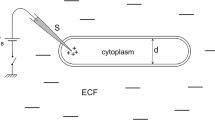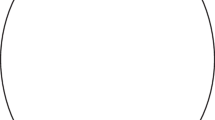Abstract
We introduce a method for computing probabilities for spontaneous activity and propagation failure of the action potential in spatially extended, conductance-based neuronal models subject to noise, based on statistical properties of the membrane potential. We compare different estimators with respect to the quality of detection, computational costs and robustness and propose the integral of the membrane potential along the axon as an appropriate estimator to detect both spontaneous activity and propagation failure. Performing a model reduction we achieve a simplified analytical expression based on the linearization at the resting potential (resp. the traveling action potential). This allows to approximate the probabilities for spontaneous activity and propagation failure in terms of (classical) hitting probabilities of one-dimensional linear stochastic differential equations. The quality of the approximation with respect to the noise amplitude is discussed and illustrated with numerical results for the spatially extended Hodgkin-Huxley equations. Python simulation code is supplied on GitHub under the link https://github.com/deristnochda/Hodgkin-Huxley-SPDE.







Similar content being viewed by others
References
Alili, L., Patie, P., & Pedersen, J. L. (2005). Representations of the first hitting time density of an Ornstein-Uhlenbeck process 1. Stochastic Models, 21(4), 967–980.
Faisal, A. A., & Laughlin, S. B. (2007). Stochastic simulations on the reliability of action potential propagation in thin axons. PLoS Computational Biology, 3(5), e79.
Faisal, A. A., Selen, L. P., & Wolpert, D. M. (2008). Noise in the nervous system. Nature Reviews Neuroscience, 9(4), 292–303.
Goldwyn, J. H., & Shea-Brown, E. (2011). The what and where of adding channel noise to the Hodgkin-Huxley equations. PLoS Computational Biology, 7(11), e1002247.
Hodgkin, A. L., & Huxley, A. F. (1952). A quantitative description of membrane current and its application to conduction and excitation in nerve. The Journal of Physiology, 117(4), 500–544.
Horikawa, Y. (1991). Noise effects on spike propagation in the stochastic Hodgkin-Huxley models. Biological Cybernetics, 66(1), 19–25.
Linaro, D., Storace, M., & Giugliano, M. (2010). Accurate and fast simulation of channel noise in conductance-based model neurons by diffusion approximation. PLoS Computational Biology, 7(3), e1001102.
Sacerdote, L., & Giraudo, M. T. (2013). Stochastic Integrate and Fire models: a review on mathematical methods and their applications. In: Stochastic biomathematical models (pp. 99–148). Springer.
Sauer, M., & Stannat, W. (2014). Analysis and approximation of stochastic nerve axon equations. arXiv:1402.4791, accepted for publication in Mathematics of Computation.
Sauer, M., & Stannat, W. (2015). Lattice approximation for stochastic reaction diffusion equations with one-sided lipschitz condition. Mathematics of Computation, 84(292), 743– 766.
Stannat, W. (2014). Stability of travelling waves in stochastic bistable reaction-diffusion equations. arXiv:1404.3853.
Tuckwell, H. C. (2008). Analytical and simulation results for the stochastic spatial Fitzhugh-Nagumo model neuron. Neural Computation, 20(12), 3003–3033.
Tuckwell, H. C., & Jost, J (2010). Weak noise in neurons may powerfully inhibit the generation of repetitive spiking but not its propagation. PLoS Computational Biology, 6(5), e1000794.
Tuckwell, H. C., & Jost, J. (2011). The effects of various spatial distributions of weak noise on rhythmic spiking. Journal of Computational Neuroscience, 30(2), 361–371.
Author information
Authors and Affiliations
Corresponding author
Ethics declarations
Conflict of interest
The authors declare that they have no conflict of interest.
Additional information
Action Editor: Brent Doiron
This work is supported by the BMBF, FKZ 01GQ1001B
Rights and permissions
About this article
Cite this article
Sauer, M., Stannat, W. Reliability of signal transmission in stochastic nerve axon equations. J Comput Neurosci 40, 103–111 (2016). https://doi.org/10.1007/s10827-015-0586-0
Received:
Revised:
Accepted:
Published:
Issue Date:
DOI: https://doi.org/10.1007/s10827-015-0586-0




